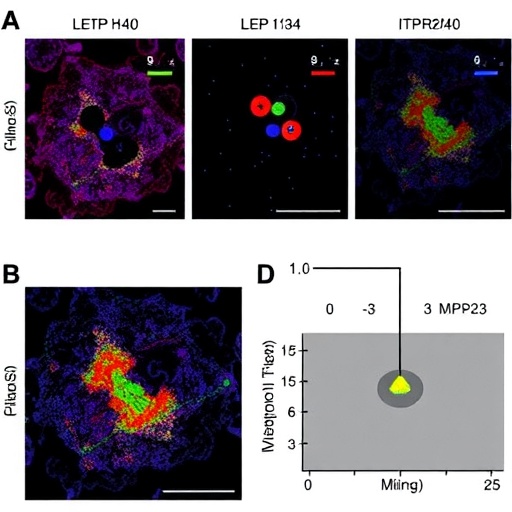In a groundbreaking study set to reshape our understanding of vitamin D metabolism in the context of obesity, researchers have illuminated the complex interactions between weight loss and vitamin D dynamics within the body. The study, conducted on a mouse model with diet-induced obesity, presents compelling evidence that weight loss not only normalizes circulating levels of vitamin D but also reverses its metabolic aberrations in adipose tissue. This revelation bridges several gaps in nutrition science and endocrinology by clarifying how adiposity can disrupt vitamin D homeostasis despite controlled cholecalciferol intake, with potential implications for human health.
Vitamin D, particularly its circulating form 25-hydroxyvitamin D (25(OH)D), is crucial for calcium homeostasis and bone health, but emerging evidence has linked it to a host of other physiological processes, including immune function, cancer prevention, and metabolic regulation. Paradoxically, individuals with obesity tend to exhibit lower circulating levels of total and free 25(OH)D, a phenomenon that has mystified scientists due to the lack of clarity regarding causality and underlying mechanisms. This study boldly addresses these uncertainties by employing a rigorous mouse model that controls vitamin D intake while inducing obesity through diet, thus isolating the effect of adiposity on vitamin D metabolism.
Throughout the investigation, male mice subjected to a high-fat diet to induce obesity showed significantly lowered plasma concentrations of total 25(OH)D as well as its biologically active free fraction. These findings aligned with human epidemiological data but offered deeper insights through the molecular analyses conducted on adipose tissue. Remarkably, after implementing a weight loss protocol, both total and free 25(OH)D levels rebounded to values comparable to non-obese controls, establishing a strong causal link between adiposity and vitamin D deficiency.
The research delved further into gene expression patterns within adipose tissue, focusing on enzymes central to vitamin D metabolism such as CYP27B1, which converts 25(OH)D into its active form 1,25-dihydroxyvitamin D, and CYP24A1, responsible for its catabolism. Obese mice displayed aberrant upregulation of catabolic pathways alongside suppression of anabolic enzymes, suggesting a localized dysregulation of vitamin D processing in fat depots. Weight loss appeared to reverse these genetic expressions, implying a restoration of vitamin D metabolic balance at the tissue level.
Interpreting these results provides a paradigm shift by highlighting that obesity-induced vitamin D deficiency might not simply be a matter of volumetric dilution or sequestration of vitamin D in excess fat mass, as traditionally believed. Instead, the tissue-specific enzymatic pathways actively alter vitamin D utilization, which might explain why supplementation alone often fails to correct deficiency in obese individuals. The study underscores the importance of integrating metabolic health strategies, such as weight loss interventions, to fully restore vitamin D status.
Moreover, the controlled dietary intake of cholecalciferol in the experimental setup ruled out nutritional insufficiency as a confounding variable, reinforcing that the observed deficiencies arise from metabolic dysregulation rather than inadequate vitamin D supply. This attention to experimental detail enhances the validity of the findings and offers a precise model to investigate therapeutic targets for metabolic diseases associated with obesity.
From a clinical perspective, this study offers a beacon of hope, suggesting that weight reduction strategies might potentiate the efficacy of vitamin D supplementation or even reduce the need for it by normalizing endogenous metabolism. Given the extensive links between obesity, vitamin D deficiency, and chronic diseases such as diabetes, cardiovascular conditions, and certain cancers, these findings could catalyze new multifaceted treatment approaches that address metabolic and nutritional dualities.
Methodologically, the use of male mice provides a controlled sex-specific model, though future research may extend these findings to female mice and other demographic variables to enhance generalizability. The comprehensive molecular profiling techniques employed, ranging from plasma assays to quantitative PCR analyses of adipose tissue, set a new standard for examining nutrient metabolism in the context of systemic disease.
Additionally, the study opens avenues for investigating the role of vitamin D metabolism within adipose tissue as an endocrine organ beyond its traditional storage function. The discovery that adipose tissue enzymatic activity dynamically adapts in obesity and weight loss offers insights into local autocrine and paracrine signaling mechanisms influencing systemic nutrient status.
The timing and dynamics of these metabolic shifts in relation to weight loss also beckon further research. Understanding how rapidly vitamin D metabolism normalizes following weight loss and the thresholds of fat reduction required could refine clinical guidelines and weight management protocols tailored to restore micronutrient balance alongside macronutrient health.
Importantly, these findings shed light on potential reasons behind the inconsistent outcomes of vitamin D supplementation trials in obese populations, many of which have not accounted for or monitored concurrent changes in body weight and adipose tissue function. This nuanced understanding advocates for more personalized interventions addressing underlying metabolic dysfunction rather than blanket supplementation strategies.
The study, published in the International Journal of Obesity, offers a robust experimental framework to explore the interaction between macronutrient intake, body composition, and micronutrient metabolism. It harmonizes well with previous epidemiological observations by reinforcing the interplay between vitamin D status and obesity pathophysiology with solid mechanistic insights.
As the field advances, these pioneering findings could stimulate translational research examining whether similar metabolic restorations occur in humans undertaking weight loss interventions such as bariatric surgery, dietary modification, or exercise regimens. Integrating such knowledge will bolster the clinical management of vitamin D deficiency in diverse patient populations affected by obesity.
Moreover, the research prompts speculation about other fat-soluble vitamins and micronutrients that might experience similar dysregulations in obesity and subsequent normalization with weight loss, heralding a new era of metabolic micronutrient research. Such investigations could redefine nutritional recommendations and therapeutic strategies across metabolic disorders.
Ultimately, this study serves as a clarion call for a comprehensive approach to obesity treatment—one that transcends calorie counting and embraces the nuanced metabolic disturbances involving vital nutrients like vitamin D. It posits that achieving a healthy weight is not merely about reducing fat mass but also about restoring the intricate biochemical networks that underpin overall health and disease resistance.
This important advancement enriches the scientific dialogue regarding obesity and micronutrient interplay. By elucidating the mechanisms whereby weight loss normalizes vitamin D metabolism both systemically and locally within adipose tissue, it offers a promising pathway toward improved health outcomes for the growing population afflicted by obesity worldwide.
Subject of Research: Weight loss effects on vitamin D metabolism in diet-induced obesity in male mice.
Article Title: Weight loss normalizes plasma and adipose tissue vitamin D metabolism, and gene expression involved in the vitamin D metabolism in male mice with obesity.
Article References:
Bonnet, L., Hachemi, A., Karkeni, E. et al. Weight loss normalizes plasma and adipose tissue vitamin D metabolism, and gene expression involved in the vitamin D metabolism in male mice with obesity. Int J Obes (2025). https://doi.org/10.1038/s41366-025-01953-9
Image Credits: AI Generated
DOI: 15 November 2025
Tags: 25-hydroxyvitamin D levels in miceadiposity effects on vitamin Dcalcium homeostasis and obesitydietary obesity and vitamin D intakeimmune function and vitamin Dimplications of vitamin D for human healthnutrition science and endocrinologyobesity and vitamin D dynamicsreversing metabolic aberrations in adipose tissuevitamin D deficiency in obese individualsvitamin D homeostasis in obesityweight loss and vitamin D metabolism





